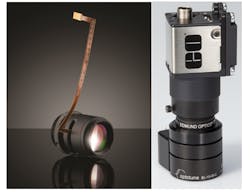When to integrate liquid lenses into machine vision optics
Nick Sischka
Throughout the last decade, liquid lenses have been among the most exciting new technologies in the machine vision space. These lenses make it possible for a single lens and camera to accomplish what would previously take multiple systems to accomplish, providing an unprecedented amount of flexibility in designing machine vision systems. While a few types of liquid lenses technologies exist on the market today, the following provides a lens-agnostic look at integrating liquid lenses—of focus tunable lenses—into machine vision optics.
Liquid lenses as a term covers a range of different lens types that use fluid as opposed to traditional glass or plastic lenses and change their curvature upon application of a current or voltage—depending on the type of liquid lens. At any given focal length, a liquid lens generally behaves like a traditional lens, as the material and the curvature determine the optical power in the lens (Figure 1). However, since a liquid lens’s curvature can change, it can effectively act like a near infinite number of lenses, since every adjustment of the curvature changes the focal length. This flexibility can be utilized to drive a working distance change in machine vision lenses.
Most traditional fixed focal length lenses change focus position by moving groups of lens elements together, while keeping the relative element spacing constraint. As an object being imaged moves farther away from the lens, the back focal length—defined as the distance from the back of the lens to the plane of focus—of the lens gets smaller. Conversely, as the distance of the object increases, the back focal length increases. This focusing methodology proves effective when needing to focus the lens once and not touch it again during operation. But with machine vision deploying into more spaces than ever before, and with newer sensor technology pushing the boundaries of system capabilities, additional flexibility is required in the optics. Liquid lenses overcome this limitation of focusability by allowing the lens assembly to focus quickly and accurately, changing its back focal length by adjusting the curvature instead of physically moving parts of the assembly.
Liquid lenses can be integrated into machine vision optics in several ways, with retrofitting onto the front or the back of the lens or inserting into the middle of existing lenses (Figure 2) representing a few options. While retrofitting can work for many applications, it is also limited in what it can accomplish. Designing the entire lens objective from the ground up around the architecture of the liquid lens represents the optimal liquid lens integration method.
Related: Flat dome lights tame reflections and shadows in machine vision
Designing a lens in such a way allows advantages such as overcoming depth of field limitations of traditional lenses and speed of changing focus. In traditional lenses, depth of field is limited by f/#--the higher the f/#, the larger the depth of field. Lenses used in logistics-based applications or barcode scanning, for example, often take advantage of the large depth of field associated with a high f/# lens but must be able to image over a large distance. Increasing the f/#, however, has two distinct disadvantages that come with the larger depth of field: loss in overall resolution, and a necessary exposure time increase, since the aperture size has been decreased and less light makes it through the system. Designing an objective with an integrated liquid lens can get around both disadvantages.
Since liquid lenses allow incredibly fast (10s of milliseconds) refocusing, a shallow depth of field lens no longer presents a problem. An objective lens with an integrated lens should be designed at as low of an f/# as possible, and do not require a variable iris like traditional machine vision lenses. Additionally, increasing the f/# on an objective with a liquid lens becomes irrelevant since its entire purpose is overcoming depth of field limitations of traditional lenses.
The increased exposure time required when f/# increases also mitigates the speed that the liquid lens can change focus as well. If the exposure must be higher to collect more light at a higher f/#, the liquid lens speed isn’t being used to its full potential. Figure 3 shows an example of a lens built around a liquid lens with no variable iris.
In addition to a fixed aperture, a lack of mechanical adjustment for focusing represents another important feature of objectives built around liquid lenses. Ideally, all focusing should be done by the changes in liquid lens curvature to simplify the focusing process, as shown in the lens in Figure 3. Retrofitting an objective with a liquid lens may require a mechanical adjustment for focusing, since the system was not initially designed to incorporate a liquid lens. Such an adjustment helps optimize performance at various distances while sacrificing range.
However, this also vastly decreases the lens’s ease of use and creates an infinite solution space of planes of focus. This infinite solution space negatively impacts performance repeatability when developing a system with multiple instances. Designing a lens that only focuses via liquid lens and not from mechanical adjustment offers a more straightforward process for lens focusing, and the performance becomes more predictable as well.
While many factors must be considered when designing an optical system with a liquid lens, the most important constraint to keep in mind is why a liquid lens is being designed into a system in the first place. Almost always, this comes down to increasing the speed and flexibility of an imaging system, and it is this paradigm that should drive all design decisions during implementation.
Nick Sischka is Manager of Imaging Sales Operations at Edmund Optics (Barrington, NJ, USA; www.edmundoptics.com)


